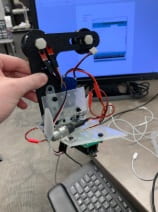Battery Testing
Goal:
To find the usage for the battery when running it at different power and time intervals.
Results:
After doing some testing about how the charge of a 12 V battery effects the voltage of the battery, it was found that a 12 Volt battery does not actually charge all the way up to 12 Volts at it’s full charge. Instead, the battery would charge to 8.6 V and be at full charge; when the battery is dead it would read around 7.2 V. Using this data, three tests were conducted with three different variables. The data goes as follows be viewed on the Data and Analysis page.
Each trial showed a high amount of accuracy and precision and lead us to discover that increasing the power by about 33% is similar to doubling the time that the AEV runs for.
Propeller Configuration Testing:
Goal:
To determine the minimum power at which an AEV with a certain propeller configuration can move, as well as the optimal configuration for power consumption reduction.
Results:
After this test it was decided that the Millennium Falcon idea would not be able to compete with the either propeller configuration of the trapezoidal base design. While the trapezoidal base covered 36 inches at its best, the Millennium Falcon required 85% motor power until it moved. When the weight was reduced, that number decreased to 65%, which was still 15% above the power cap issued at 50%. Exceeding this cap for any substantial amount of time could lead to the motors burning out, and thus the trapezoidal base design became the main AEV for testing. While the second propeller configuration for the trapezoidal base performed the best, it also inhibited connection to the caboose, meaning that configuration 1 would now be the final propeller configuration and base design. For a deeper look inside of the data, please visit our Data and Analysis page.
Power Breaking Testing
Goal:
To determine the best way to bring the AEV to a complete stop; whether it be through a reverse and running for less than a second, to coast the AEV, or bring it to an immediate stop.
Results:
The first step of the power breaking testing required finding the power interval, or power difference, that would stop the AEV instantly. This was accomplished by reversing the motors and having them decelerate on 0.15 seconds to a complete stop, then measuring how far the AEV traveled between the AEV motors reversing and the vehicle coming to rest via a recording. It was determined that a power difference of 20% stopped the AEV immediately after the motors were reversed.
The second part of the testing integrated the results of the battery testing. Because it is known that running the motors at a lower power for a longer time is more energy efficient, deceleration loops, in which the AEV would decelerate to zero numerous times were then explored as a possible breaking method. It was determined that the best way to stop an AEV moving forward at 39% motor power, the run speed of the AEV, was to have it decelerate from 54% twice. This consistently led to a stopping distance of 3 inches.
For a further look into the data, please reference the Data and Analysis page.


